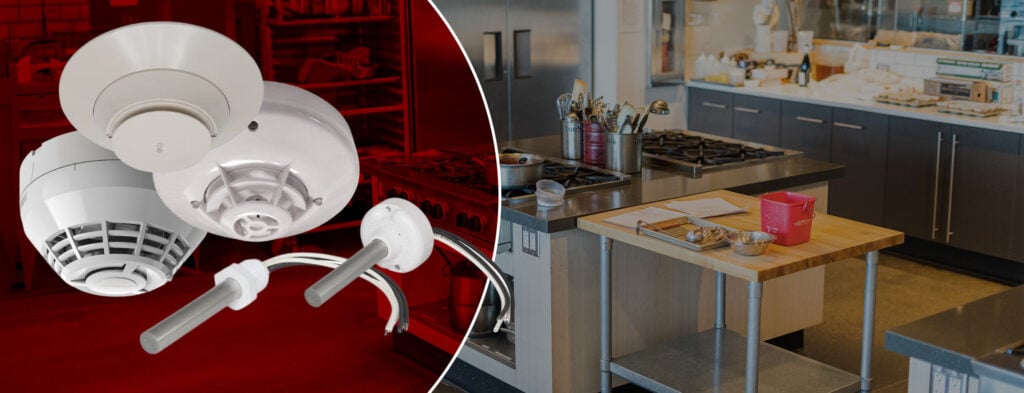
Heat detectors are devices that are capable of detecting fires due to the rapid increases in temperature caused by fires. These devices are essential in occupancies that expects high amounts of air pollution, steam, and other contaminants that would interfere with typical smoke detection devices. Commonly used in cooking facilities, industrial rooms, and storage facilities, heat detectors trigger alarms using three primary methods: rate compensation, rate of rise, and fixed temperature heat detection. Unlike smoke detection methods, heat detection results in less false alarms, especially in polluted and high airflow spaces. Keep reading to learn more about how these methods work.
A fixed temperature heat detector is a simple device that only triggers when the temperature hits a predetermined heat level. This detection can be carried out by a thermistor device, or through simpler, mechanical technologies. Bimetallic strip detectors or fusible alloys physically melt or distort when in contact with heat. This kind of mechanical heat detection is used on sprinklers for their cost-effectiveness. On the other hand, thermistors provide a more accurate and responsive way of detecting heat.
Modern heat detectors often contain a thermistor, which is an electrical resistor that changes properties when introduced to heat. At lower temperatures, it has a high resistance, which only allows a little electrical current to flow. In contrast, once higher temperatures are reached, the resistance of the thermistor decreases, allowing more current to flow. Consequently, the higher electrical current triggers the alarm state of the fire alarm system. Even more, a microcontroller can be used to monitor the temperature of the thermistor. This controller offers precise control over when alarm signals are sent, meaning a thermistor can be found on all three detector types. These detectors are reliable, accurate, and respond quickly to high temperatures.

The Thermotech 302-EPM-194 is a rate compensation heat detector suitable for hazardous locations
A rate of rise heat detector is triggered when the ambient temperature increases at a certain rate. To elaborate, this means that the detector is triggered by spikes in temperature rather than at a predetermined fixed temperature. We can expect rapid spikes in temperature when there is radiant heat from nearby flames or hot air rising towards the detector. This mechanism works because rate-of-rise detectors have an air chamber with a small vent. When heat rapidly increases, air inside expands quickly, building pressure that actuates a diaphragm or bellow. The actuation of the diaphragm closes an electrical contact that allows current to flow, which activates the alarm. Slower temperature changes allow air to escape from the air vent, thereby preventing false alarms.
According to the NFPA 1, a rate compensation detector is “a device that responds when the temperature of the air surrounding the device reaches a predetermined level, regardless of the rate of temperature rise.” Rate compensation detectors are also called combination detectors, since they incorporate the principles of both rate-of-rise and fixed- temperature detection. This allows activation at a specific, pre-calibrated temperature, while concurrently mitigating the effects of thermal lag, which is the inherent delay in a detector achieving ambient temperature. A rate compensation detector is typically constructed with two metallic components or a sealed metal tube with internal struts, each engineered to exhibit differential expansion rates when exposed to heat. This construction allows the detector to anticipate full temperature conditions during rapid thermal increases, thereby enhancing detection efficiency.
| Feature | Rate-of-Rise Heat Detector | Rate-Compensated Heat Detector |
|---|---|---|
| Trigger Logic | Activates based on a rate of temperature increase (ex. 15°F/min). | Activates based on reaching a fixed temperature set point, but compensates for thermal lag for greater accuracy. |
| Fire Type | Best for rapidly developing, flaming fires. | Excellent for both slow-smoldering and fast-flaming fires; aims for precise activation at the rated temperature. |
| Thermal Lag | Can still experience some thermal lag, especially if only a fixed-temperature component is present or if the rate of rise is just below its threshold. | Specifically designed to compensate for and minimize thermal lag. |
| False Alarms | Can be prone to nuisance alarms from sudden, non-fire heat surges. | Generally, more resistant to false alarms from temporary heat fluctuations. |
For spaces that focus on life safety, smoke detectors are more favorable, especially when there is little air contamination. Slow-burning fires have a smoldering phase that causes a gradual increase in heat. During the smoldering phase, smoke is released before temperatures rise to higher levels. During this phase, rate compensated detection or smoke detection will offer earlier detection than a rate-of-rise heat detector. Additionally, occupancies that experience temperature fluctuations regularly as a part of normal operations should not utilize a rate-of-rise heat detector. Regular temperature spikes may cause false alarms or ineffective detection. Areas that regularly experience these temperature fluctuations are commercial kitchens, boiler rooms, areas near HVAC equipment, or industrial processing rooms.
Heat detectors are crucial fire safety devices, excelling in contaminant-rich environments where smoke detectors falter. Employing fixed-temperature, rate-of-rise, and rate compensation methods—often utilizing precise thermistors—they offer reliable, low-false-alarm detection. While fixed-temperature detectors activate at a set point and rate-of-rise respond to rapid temperature spikes, rate compensation detectors uniquely combine both, accurately activating at a predetermined temperature while mitigating thermal lag for diverse fire types. However, knowing and selecting the appropriate type is essential for effective fire protection.
Are you interested in purchasing heat detectors for your system? Explore our stock of commercial linear heat detectors, combination detectors, detector accessories, and more!
$253.49
$41.49
$36.99
$107.99
$54.49
$40.99
$22.49
$76.49